Monday, August 17, 2020 by Gabrielle Martin
An at-home workstation is a sign of the times: just as the pandemic caused a shift to remote workplaces, coronavirus-related school closings resulted in the transition to online learning. As the coronavirus continues to be a pervasive force impacting in-person education, parents across the nation are all thinking the same thing: “What’s going to happen this September?"
The latest Hingham Public schools reopening plan from Superintendent of Schools Paul Austin emphasizes a phase-in remote/hybrid learning plan, meaning Hingham students will likely be learning-from-home some of their fall semester.
Parents are doing their best to prepare for remote learning, but let’s be honest: it’s all a bit overwhelming.
To help, we’ve called in the organization experts to share their advice and opinions on all things decluttering and design; we also consulted a town teacher for her tips and tricks to facilitate at-home learning success. Here’s how to maximize the available workspaces in your home!
SHAUNA YULE BRASSEUR of LOVELY LIFE HOME:
“Home organizing, decluttering, and design.”
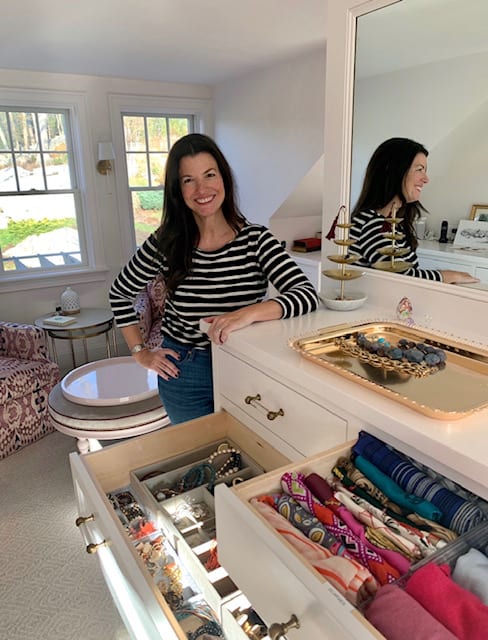
Do: Think about what their classroom would look like and go from there.
It’s important to be age-appropriate! Shauna Brasseur of Lovely Life Home says, “Elementary school classrooms usually have desks or tables that are kept clear; supplies are then brought out as they are needed. These uncluttered spaces help kids focus, so you should keep things simple at home, too. Younger kids are usually happiest working close to you, so maybe it’s the kitchen table or the island.”
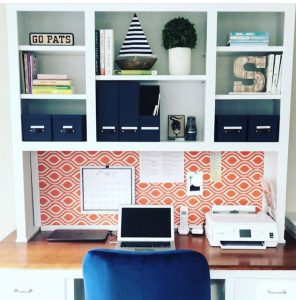
Brasseur’s advice? “Keep a craft caddy stocked with school supplies–pencils, markers, Crayons, scissors, a ruler, et cetera–and an upright magazine holder for workbooks and worksheets. Upright magazine holders are also perfect for things like copy paper and construction paper. Since they’ll be working in the family space, carve out a spot for them to put their caddy and magazine holder away at the end of the school day, just like they would at school!” This will assist in returning a sense of normalcy to the new normal.
And, in case you haven’t already, you are long overdue in investing in a label-maker. Right now, that’s a pretty powerful purchase; your label-maker may just be your new best friend this back-to-school season!
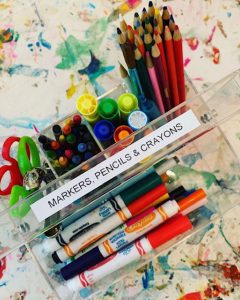
Pro-tip: “Make it part of the routine to charge any devices that they’ll need for the next day.”
Don’t: Buy a desk they won’t really need.
“Many elementary-aged kids aren’t ready to work alone in their rooms, so don’t feel like you need to buy them a desk. Kids in middle or high school (and even college students!) probably already have desks in their rooms. Before school starts, work together to get them cleaned out and set them up with a drawer organizer that they can use to keep their supplies.”

If they have lots of textbooks and binders: “Use a clear bin next to the desk so that everything can be stored off of the desk! The Dollar Store is a great place to find things like this.”
Pro tip: “Store things spine up so that it’s easy to find what you have!”
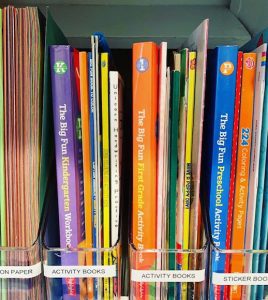
Do: Set a schedule.
“Kids love routine; they like to know what’s coming next! For days that they are working from home, post a schedule so that they know what to expect. Make a plan for snacks and lunch! Maybe kids will make their lunches and get their snacks like they always have. If you’re making lunch, set a menu at the start of the week and write or print it out so that you can just gleefully point to it when you are invariably asked, ‘What’s for lunch?’”
Pro-tip: “Some kids like having a small clock so that they can keep track of time.”
Don’t: Make it extravagant, outrageous, or over-the-top.
I know you’re trying to compensate for your child missing their classroom, but creating a space that’s more flashy than functional is just distracting! Brasseur advises, “Keep it simple so your child can focus.”

For the younger crowd: “It’s easy to carve out a cozy space to read, if you’d like that to be a part of your smaller kids’ day. Just add a basket of books and pillows to a corner and call it a reading nook."
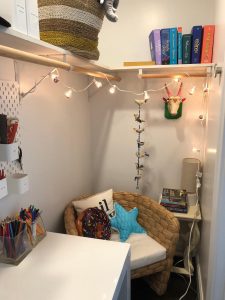
Think outside-the-box—or, should I say, inside the closet! Shauna says, “You may be able to carve a study space out of a closet—and it doesn’t even need to be a walk-in! If you have a deep closet, you can make room for a desk. We used a pegboard for school and art supplies so that everything was off the desk; then there was more room to work. We even tucked a chair into the corner of the closet and made the coziest reading nook!”
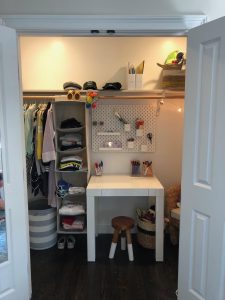
Making the most of the space you have: “This once was a dumping ground for dirty clothes. Now, with the addition of string lights and a little lamp (using an extension cord), it’s such a great private space—something that we are all really craving. Plus, at the end of the school day, the doors can be closed so that kids don’t always feel like they are living in a classroom.”
Pro-tip: “It might be more important to think about what you can take away, than what you should add,” Shauna states.
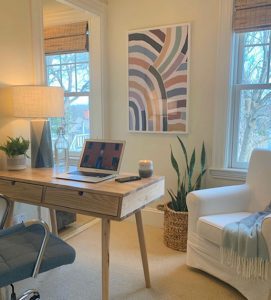
JEN RENNA of SIMPLY ORGANIZED HINGHAM:
“Lover of all bins, labels, and simple organized solutions.”
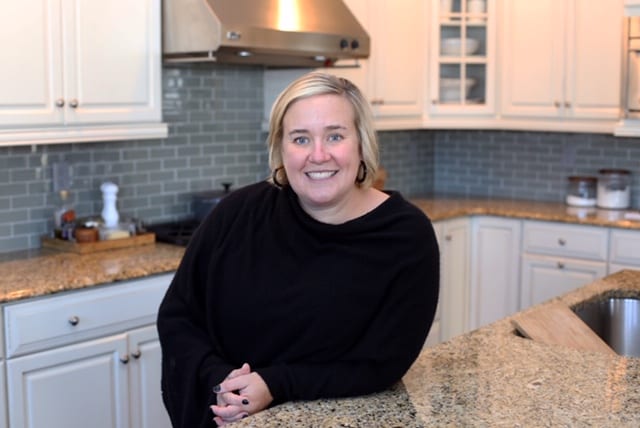
Do: Get creative.
“I think everyone was caught off guard when school went remote. I mean, who could have ever imagined?” Jen Renna of Simply Organized Hingham says, speaking from personal experience. “We didn’t have an immediate, ideal situation for both of our kids to have an online remote learning space, but we did have space. It took a little trial-and-error to settle in for all of us.”

How Renna approached at-home learning in her household: “Our middle schooler luckily had a desk in her room that we quickly cleared off for her to use. We don’t have an office in our house, but what we do have is a really large closet that we built a desk into when we first moved in, never thinking it would become our 2nd remote learning space! I don’t think there are any set rules for a perfect learning space and it is certainly kid specific.”
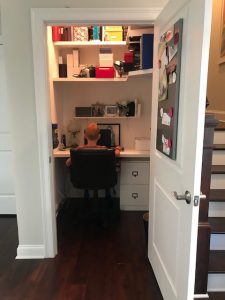
Don’t: Set up shop in a high-traffic zone in the house.
“The main criteria for my kids homeschooling workstations was to be out of the way of the daily ‘traffic’ in the house. When we first started, we set up at the kitchen island with both kids and quickly realized that was not going to work. Not only did they end up talking to each other, but I would often find them staring at me putting away the groceries or emptying the dishwasher. We pivoted quickly and found them their own space.”
Jen’s advice: “Most homes won’t have the ideal quiet space away from everyone, so adjust as necessary! Have the kids work in shifts, trading off time alone.”
Pro-tip: “Consider all areas of the house while thinking of a space and make it as quiet as possible.”
Do: Be prepared.
“I think it’s important to make sure they have everything they may need to complete their schoolwork at arms-reach, to take away excuses to get up and find a pencil or stapler! I even included a water bottle before my kids sat down for school to eliminate that request while working.”
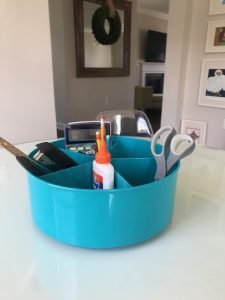
Simply organized: “In each of my kids’ spaces, I have stocked a lazy susan (picture provided) with all of the items they could need to complete the school work for the day,” Renna shares.
Those items include:
- Post-Its,
- A stapler (with extra staples!),
- A ruler,
- Glue,
- Sharpened pencils with erasers,
- Scissors,
- Sharpies and/or Expo markers,
- A calculator.
Pro-tip: “I also made sure we always have extra printer paper on the shelf, as well as printer cartridges–there’s nothing worse than running out midday!”
Don’t: Throw everything away!
What Renna learned, the hard way: “Throughout homeschooling, we learned the importance of storing the printed worksheets and miscellaneous papers until they got the final sign-off from their teacher. Lots of frustration from my kids when they had to repeat something that they had tossed by accident.”
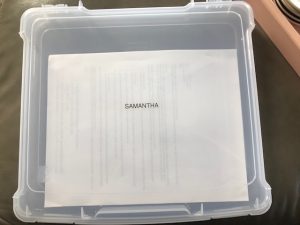
“What worked for us was a plastic project case from The Container Store,” Jen confesses. “The kids would put everything in it that they printed or worked on from the wee; once we got the all-clear from their teacher, we would go through and clean it out for the next week.”
Do: Clear the clutter.
Renna believes her kids “work best when they start with a clean, non-cluttered space away from each other and the movement in the house.”

Pro-tip: “After your kids are done with school for the day, make sure you have them clean up any supplies, extra papers, trash, etc. so that they can start each morning with a clean slate. That will encourage them to be as productive as possible.”
NATALIE ALLEN, TEACHER at HINGHAM HIGH SCHOOL:
Do: Keep thorough track of assignments and engagements.
Natalie Allen is a teacher at Hingham High School. Fun fact: I actually had Mrs. Allen during my time at Hingham High! I always remembered her incredible organization skills from when she was my teacher, so I reached out to get her opinion on how to best create an at-home workstation. Not only in Mrs. Allen an experienced educator, she's also a mom of two, so I felt she had a very valuable perspective to offer this article.
She says, “Students should still maintain an agenda book to keep track of short- and long-term assignments; parents might also consider a whiteboard calendar to hang near each child’s workspace. Especially on days when kids at at-home for remote learning, it might be helpful to see a schedule of Zoom engagements.”
I have been a fan of agendas for as long as I can remember! Agenda and planners are great methods for keeping students motivated and on-task. You can even find personalized agendas online now, tailored to each students’ needs, interests, and age. Another option? Get a blank notebook and fill it out as an agenda: DIY!
Allen herself is a self-described planner: “I like to organize my workday by the hour, and then each teaching hour by 15-minute chunks. Additionally, I keep checklists to hold myself accountable. I am old-school and rely on my pen-and-paper plan book and calendar!”
Don’t: Overcrowd at-home learning spaces in an attempt to mimic a communal, classroom feel.
Sure, your child misses socializing, but it's important to designate different spots in your home for each of your children. Allen offers this advice: “With the likelihood that kids will be Zooming with their teachers and classmates this school year in place of some in-person instruction, you will be happy that your kids have their own space so that they will not distract each other!”
She says she learned this firsthand with her own two children. Allen suggests, “If your kids don’t have work spaces in their rooms, then consider designating different spots in the house for each child, if possible.”
Remember: There’s no time like the present!
In many ways! Firstly, and I know everybody keeps saying it, but that's doesn’t distract from the truth: we are living in absolutely unprecedented times. There really is no time like the present—at least, not that we’ve experienced before. It’s important to be patient with ourselves and others during these tumultuous times.
“This year is going to look so different from years past,” Allen acknowledges. She says, “I’m trying to plan for every possible scenario so that I can help my students and my own children get the most out of our new model. And that’s all starting now, two weeks before I report to school! I’m clearing out clutter so that every space in the house feels peaceful and conducive to work.” So, secondly, there’s no time like the present: now is the perfect time to get your at-home workstation in order.
Perspective and Reflection
Of course, I feel it’s important to end this article with some perspective of privilege: not all of us are fortunate enough to have the resources (or room!) for remote learning spaces. However, there are still a lot of simple things that can be done to make the most of an at-home workspace. I’d like to think a lot of other tips and tricks included in this article are across-the-board accessible and achievable.
Special thanks to Shauna Brasseur, Jen Renna, and Natalie Allen for their contributions!
How are you preparing your home for Hingham’s hybrid learning? Share your strategy in the comments below!


